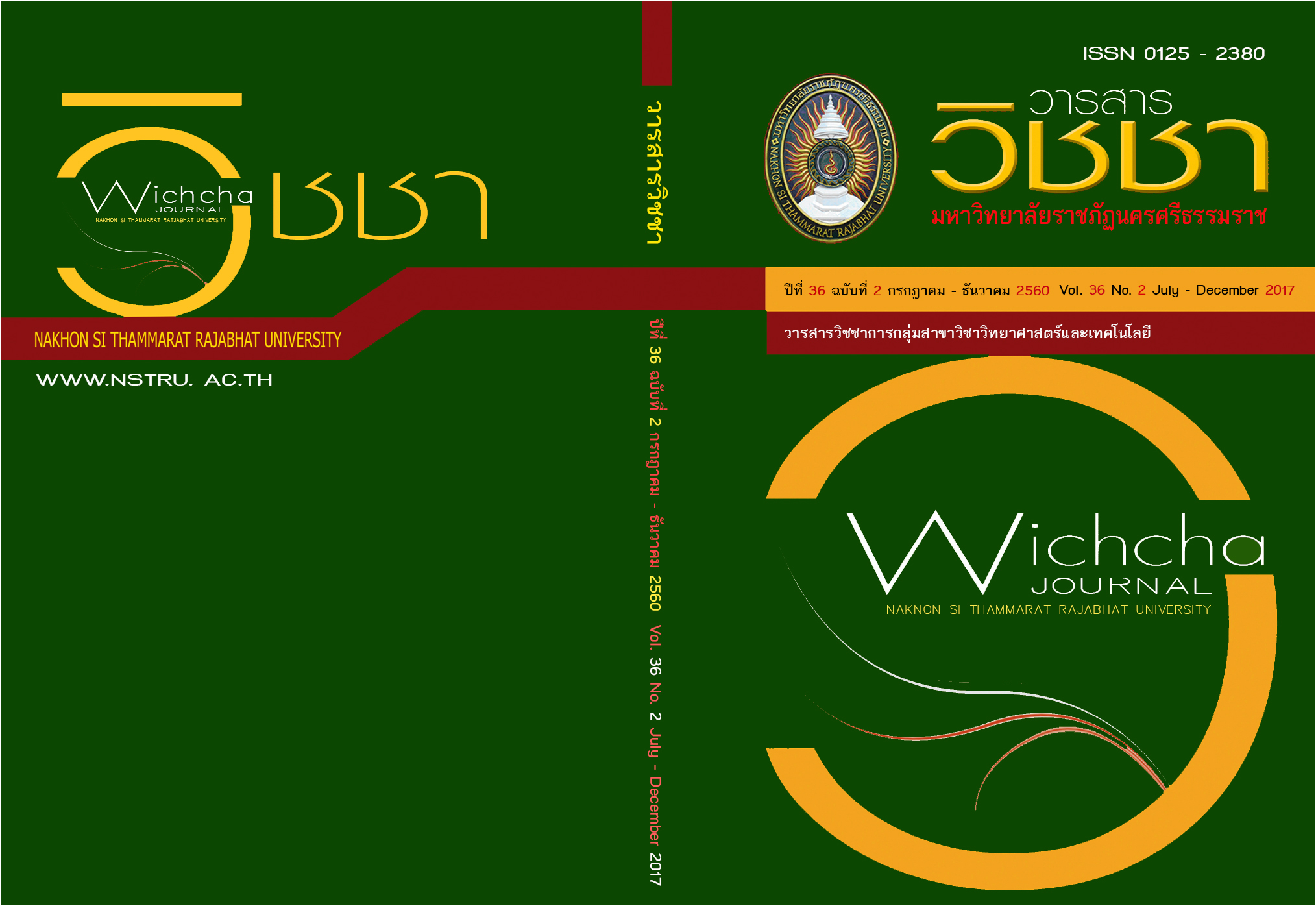Isolation and Identification of Soil Fungi from Mangrove In Nakhon Si Thammarat Province
Main Article Content
Abstract
The aim of this study was to isolate and identify soil fungi in mangrove areas in Muang, Pakpanang and Thasala Districts, Nakhon Si Thammarat Province. The morphological study of fungi showed that from the total of 161 isolates, 124 isolates (77.0%) produce spores and can be classified. Penicillium spp. were found to be the most dominant fungi (52 isolates; 32.3%) followed by Aspergillus spp. (43 isolates; 26.7%), Trichoderma spp. (19 isolates; 11.8%), Fusarium spp. (6 isolates; 3.7%), Drechslera spp. (2 isolates; 1.2%), Gongronella sp. (1 isolate; 0.6%) and Dendryphiopsis sp. (1 isolate; 0.6%). Thirty-six isolates (22.4%) did not sporulate being classified as mycelia sterilia while one isolate (0.6%) produced spore but cannot be classified. The results of this study revealed the types of fungi isolated from mangrove soil. This information can be used to support further studies in term of fungal activities.
Article Details
เนื้อหาและข้อมูลในบทความที่ลงตีพิมพ์ในวารสารวิชชา มหาวิทยาลัยราชภัฏนครศรีธรรมราช ถือเป็นข้อคิดเห็นและความรับผิดชอบของผู้เขียนบทความโดยตรง ซึ่งกองบรรณาธิการวารสารไม่จำเป็นต้องเห็นด้วยหรือร่วมรับผิดชอบใด ๆ
บทความ ข้อมูล เนื้อหา รูปภาพ ฯลฯ ที่ได้รับการตีพิมพ์ในวารสารวิชชา มหาวิทยาลัยราชภัฏนครศรีธรรมราช ถือเป็นลิขสิทธ์ของวารสารวิชชา มหาวิทยาลัยราชภัฏนครศรีธรรมราช หากบุคคลหรือหน่วยงานใดต้องการนำข้อมูลทั้งหมดหรือส่วนหนึ่งส่วนใดไปเผยแพร่ต่อหรือเพื่อการกระทำการใด ๆ จะต้องได้รับอนุญาตเป็นลายลักษณ์อักษรจากวารสารวิชชา มหาวิทยาลัยราชภัฏนครศรีธรรมราชก่อนเท่านั้น
The content and information in the article published in Wichcha journal Nakhon Si Thammarat Rajabhat University, It is the opinion and responsibility of the author of the article. The editorial journals do not need to agree. Or share any responsibility.
References
สำนักอนุรักษ์ทรัพยากรป่าชายเลน กรมทรัพยากรทางทะเลและชายฝั่ง. (2555). พื้นที่ป่าชายเลนของประเทศไทย. กรุงเทพมหานคร : กรมทรัพยากรทางทะเลและชายฝั่ง.
โสภนา วงศ์ทอง. (2544). ความหลากหลายทางชีวภาพของเชื้อราชั้นสูงในป่าชายเลน ณ สถานีวิจัยทรัพยากรชายฝั่งระนอง. วิทยานิพนธ์วิทยาศาสตรมหาบัณฑิต สาขาจุลชีววิทยา. มหาวิทยาลัยเกษตรศาสตร์.
Ananda, K. & Sridhar, K.R. (2004). Diversity of filamentous fungi on decomposing leaf and woody litter of mangrove forest in the southwest coast of India. Current Science, 87, 1431-1437.
Barnett, H.L. & Hunter, B.B. (1998). Illustrated Genera of Imperfect Fungi. 4th Edition. American Phytopathological Society, Minnesota, USA.
Broder, M.W. & Wagner, G.H. (1986). Microbial colonization and decomposition of corn, wheat, and soybean residue. Soil Science Society of American Journal, 52(1), 112-117.
Charudattan, R. & C. Y. Lin. (1974). Isolates of Penicillium, Aspergillus, and Trichoderma toxic to aquatic plants. Hyacinth control Journal, 12, 70-73.
Domsch, K.H., Gams, W. & Anderson, T.W. (1993). Compendium of Soil Fungi Volume I. IHW Verlag Press. London, UK.
Duong, L.M., Jeewon, R., Lumyong, S. & Hyse, K.D. (2006). DGGE coupled with ribosomal DNA phylogenies reveal uncharacterized fungal phylotypes on living leaves of Magnolia liliifera. Fungal Diversity, 23, 121-138.
Fontaine, S., Barot, S., Barre, P., Bdioui, N., Mary, B. & Rumpel, C. (2007). Stability of organic carbon in deep soil layers controlled by fresh carbon supply. Nature, 450, 277-280.
Gilna, V.V. & Khaleel, K.M. (2011). Diversity of fungi in mangrove ecosystem. Journal of Experimental Science. 2(2), 47-48.
Huang, Z., Yang, R., Gu, Z., She, Z. & Lin, Y. (2010). A new Naptho--pyrone from mangrove endophytic fungus ZSU-H26. Chemistry of Natural Compounds, 46, 15-18.
Hyde, K.D. & Lee, S.Y. (1995). Ecology of mangrove fungi and their role in nutrient cycling – what gaps occur in our knowledge. Hydrobiologia, 295, 107-118.
Ito, T. & Nakagiri, A. (1997). Mycofloral study on mamgrove mud in Okinawa, Japan. Research Communication, 18, 32-39.
Ito, T., Nakagiri, A., Tanticharoen, M. & Manoch, L. (2001). Mycobiota of mamgrove forest soil in Thailand. Institute of fermentation Osaka. Research Communication, 20, 50-60.
Johnson, M.C., Pirone, T.P. Siegel, M.R. & Varney, D.R. (1982). Detection of Epichloe typhina in tall fescue by mean of enzyme-linked immunosorbent assay. Photopathology, 72, 647-650.
Johnston, P.R. Sutherland, P.W. & Joshee, S. (2006). Visualising endophytic fungi within leaves by detection of (1-3)-ß-D-glucans in fungal cell wall. Mycologist, 20, 159-162.
Jones, E.B.G. (2000). Marine fungi: some factors influencing biodiversity. Fungal Diversity, 4, 53-73.
Jones, E.B.G., Pilantanapak, A., Chatmala, I., Sakayaroj, S., Phongpaichit, S. & Choeyklin, R. (2006). Thai marine fungal diversity. Songklanakarin Journal of Science and Tchnoloy, 28(4), 687-708.
Jones, E.B.G., Sakayaroj, S., Suetrong, S., Somrithipol, S. & Pang, K.L. (2009). Classification of marine Ascomycota, anamorphic taxa and Basidiomycota. Fungal Diversity. 35, 1-187.
Kathiresan, K., Bingham, B.L. (2001). Biology of mangrove and mangrove ecosystem. Advances in marine biology, 40, 81-251.
Kristensen, E., Bouillion, S., Dittmar, T. & Marchand, C. (2008). Organic carbon dynamics in mangrove ecosystems; a review. Aquatic Botany, 89, 201-219.
Maria, G.L. & Sridhar, K.R. (2003). Diversity of filamentous fungi on woody litter of five mangrove plant species from the southwest coast of India. Fungal Diversity, 14, 109-126.
Nikolcheva, L.G. & Bärlocher, F. (2004). Taxon-spcific fungal reveal unexpectedly high diversity during leaf decomposition in stream. Mycological Progress, 3(1), 41-49.
Nikolcheva, L.G. & Bärlocher, F. (2005). Seasonal and substrate preferences of fungi colonizing leaves in streams: traditional versus molecular evidence. Environmental Microbiology, 7(2), 270-280.
Seena,S.,Wynberg, N. & Bärlocher, F. 2008. Fungal diversity during leaf decomposition in a stream assessed through clone libraries. Fungal Diversity, 30, 1-14.
Shao, C., Guo, Z., Peng, H., Peng, G., Huang, Z., She, Z., Lin, Y. & Zhou, S. (2007). A new Isoprenyl phenyl ether compound from mangrove fungus. Chemistry of Natural Compounds, 43, 377-380.
Shearer, C.A., Descals, E., Kohlmeyer, B., Kohlmeyer, J., Marvanova, L., Padgett, D., Porter, D., Raja, H.A., Schmit, J.P., Holly, A., Thorton, H.A. & Voglymayr, H. (2007) Fungal diversity in aquatic habitats. Biodiversity and Conservation, 16, 49-67.
Song, Y., Wang, J., Huang, H., Ma, L., Wang, J., Gu, Y., Liu, L. & Lin, Y. (2012). Four eremophilane sesquiterpenes from the mangrove endophytic fungus Xylaria sp. BL321. Marine Drugs, 10, 340-348.
Spalding, M., Blasco, F. & Field, C. (1997). World mangrove atlas. Cambridge Samara Pub. Co., Cambridge, UK.
Tao, G., Liu, Z.Y., Hyde, K.D., Lui, X.Z. & Yu, Z.N. (2008). Whole rDNA analysis reveals novel an endophytic fungi in Bletilla ochracea (Orchidaceae). Fungal Diversity, 33, 101-122.
Thatoi, H., Behera, B. & Mishra, R. (2013). Ecological role and biotechnological potential of mangrove fungi: a review. Mycology, 4(1), 54-71.
Yang, C.H., Crowley, D.E., Borneman, J. & Keen, N.T. (2001). Microbial phyllosphere population are more complex than previously realized. Proceeding of the National Academy of Sciences of the United State of America, 98, 3889-3894.
Yonathan, A., Marchand, C., Wartel, M. & Record, E. 2011. Fungal diversity in anoxic-sulfidic sediments in a mangrove soil. Fungal Ecology, 5(2), 282-285.


